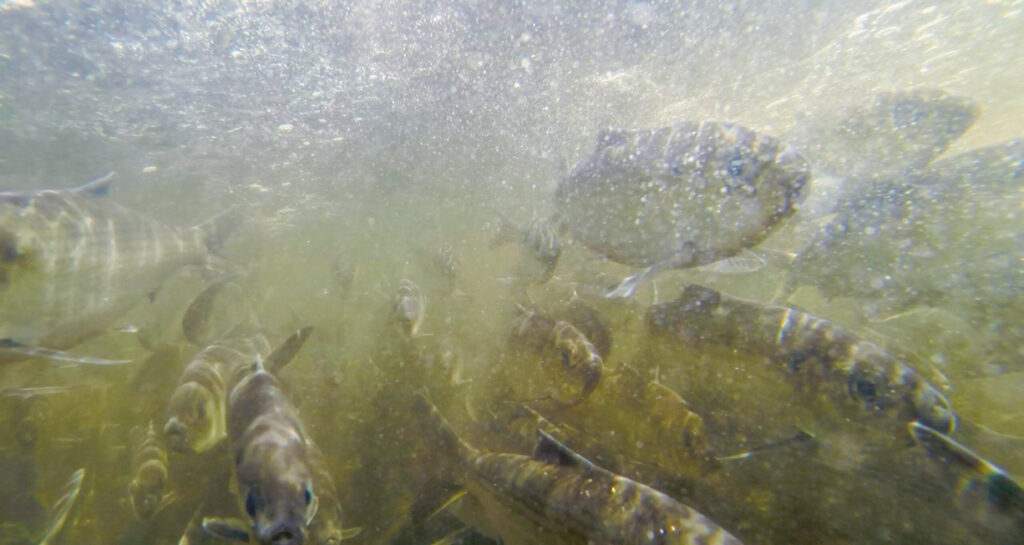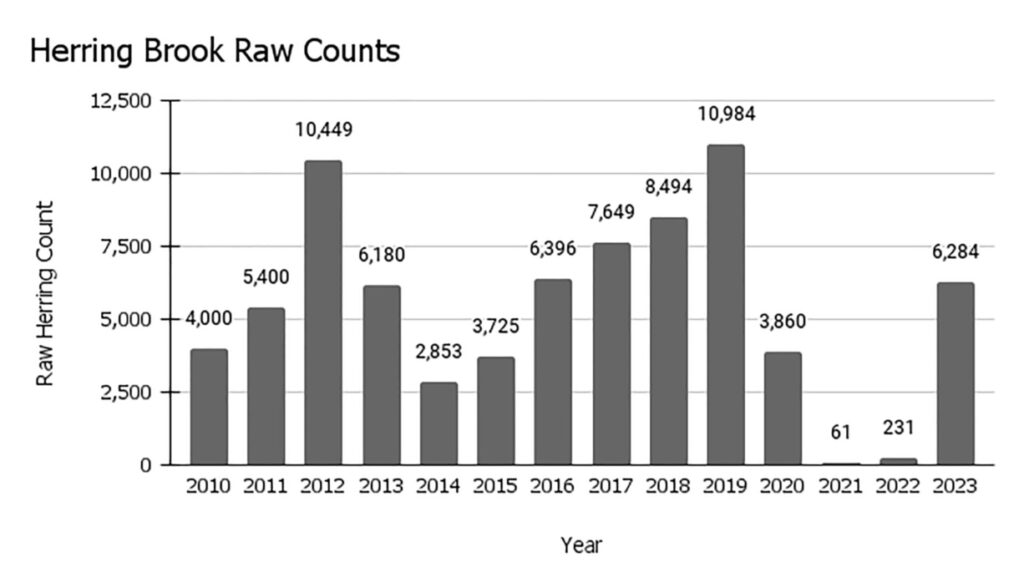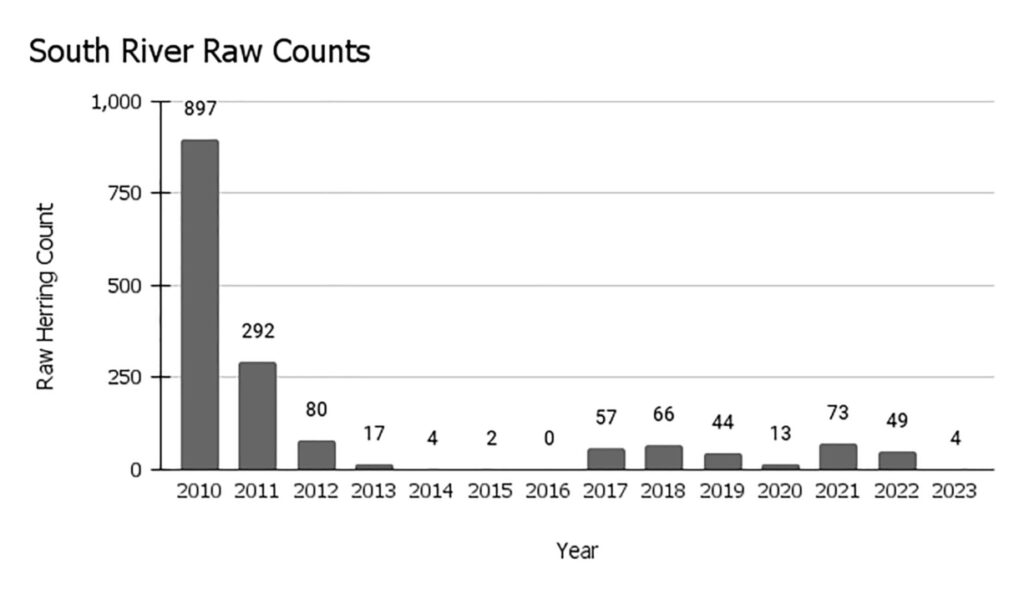 This spring, over 100 of our devoted volunteers spent more than 227 hours watching and waiting for river herring to make their way upstream to their annual spawning locations. Volunteers counted 6,453 fish passing our monitoring sites this season, migrating into First Herring Brook, Third Herring Brook, Herring Brook, Bound Brook, Tidmarsh, and the South River from March 27th – May 31st.
This spring, over 100 of our devoted volunteers spent more than 227 hours watching and waiting for river herring to make their way upstream to their annual spawning locations. Volunteers counted 6,453 fish passing our monitoring sites this season, migrating into First Herring Brook, Third Herring Brook, Herring Brook, Bound Brook, Tidmarsh, and the South River from March 27th – May 31st.
WHAT WE DO
The yearly spring migration is an important journey for river herring that is made difficult by obstacles such as dams, drought, pollution, and predation. Volunteer efforts to track this journey give us an idea of how many fish travel successfully to our monitored locations each year. We monitor streams all throughout the South Shore, including Herring Brook, South River, First Herring Brook, Third Herring Brook, and Bound Brook, and partner with MassAudubon to monitor Beaver Dam Brook in Plymouth.
Stewardship efforts have led to the restoration of many streams in the area, which have increased the number of migrating herring in the past 10 years. One such stream, Herring Brook, had no fish before it was stocked in the late 2000s. The restoration efforts were very successful and led to Herring Brook having a substantial annual population of migrating fish.
In the past few years, we have seen a decline in the number of migrating herring in many streams across the South Shore. There are a few hypotheses as to the cause of the decline, such as lower freshwater flows as a result of droughts, ocean trawling, poor water quality, and changing conditions as a result of climate change. This year we saw an overall recovery in our rivers, which is great news!
The work of our volunteers has been key to the detection of these population changes, and the data they collect support population estimates that can give scientists and ecosystem managers alike a better clue into protecting these fish. We would like to extend a huge thank you to our dedicated volunteers for your part in making an impact!
RIVER HERRING RAW DATA COUNT SUMMARY
Raw counts are the number of individual fish that are directly observed and recorded by volunteers: not the entire local population, but instead a tool to then determine the population. Our raw count data is sent to the Division of Marine Fisheries to be aggregated into an algorithm that estimates population size.
| Location | Raw Counts 2023 | Peak in the Last 10 Years |
| Bound Brook | 0 | 4 (2020) |
| First Herring Brook | 0 | 40 (2021) |
| Herring Brook | 6,248 | 10,984 (2019) |
| South River | 4 | 73 (2021) |
| Third Herring Brook: Tack Factory | 19 | 345 (2020) |
| Third Herring Brook: Jacob’s Pond | 0 | 2,635 (2017) |
| Tidmarsh #1 | 0 | 22 (2022) |
| Tidmarsh #2 | 251 | 251 (2023) |
 INDIVIDUAL SITES
INDIVIDUAL SITES
Bound Brook – Scituate and Cohasset
Bound Brook is unique in that it is affected by the Hunters Pond dam that was removed six years ago. As with many of our dam removal projects in systems that had extirpated herring populations, we have seen them struggle to recover as the only fish that enter the system are “scouts” exploring new streams. Still, there is hope for more coming into the system, especially since herring that pass the Hunters Pond site have passage via two fish ladders to a large amount of habitat in the Aaron River Reservoir, as well as renewed interest in reinvigorating this herring population.
First Herring Brook – Scituate
Counts at First Herring Brook have been hanging in the low numbers since flow was restored to the Old Oaken Bucket fish ladder in 2012. Last year volunteers counted 10 herring, but this year the count was down to 0 – remember, these are raw count numbers and not the population. NSRWA is working closely with the Town of Scituate to continue to provide flows for herring and instream habitat and is working on expanding potential habitat by improving access to the Reservoir upstream.
Herring Brook – Pembroke
Herring Brook is home to our most robust herring population- this year volunteers counted 6,248 herring passing the ladder, which is a 26x increase from our counts of 231 the previous year!

South River – Marshfield
Volunteers at the South River did not see many herring at the Veterans Memorial Park fish ladder this year, only 4, down from the counts of last year’s 49. The fish ladder is very sensitive to changes in flow and can be difficult to manage. We are also working with the Town of Marshfield and Mass. Division of Ecological Restoration to remove the dam and replace it with a nature-like fishway.

Third Herring Brook – Tack Factory and Jacob’s Pond, Norwell
Herring counts were conducted at the Tack Factory Dam removal site. Volunteers saw 19 herring pass the site this year, an increase from last year’s count of 0. We are beyond happy to see herring moving up into the Third Herring Brook system, especially since we removed the last dam on the brook, Peterson Pond Dam behind the Hanover Mall, in the fall of 2020. Our volunteers also checked for the presence of herring at the Jacob’s Pond culvert but saw none. The Jacob’s Pond Dam is the site of a future fish ladder that will allow herring to access 62 acres of habitat.
Beaver Dam Brook – MassAudubon Tidmarsh Wildlife Sanctuary, Plymouth
Volunteers counted herring at two sites within the Tidmarsh Wildlife Sanctuary. Site #1 saw 0 herring, however, volunteers counted 251 at Site #2, up from the 57 counted last year, which is also the highest count we have recorded at the site in the last ten years!
Thank you again to all of our volunteers – we hope you will join us in 2024!
Herring Run the River and Hudanich Family Counting Herring Copyright Trillium Studios 2020.
